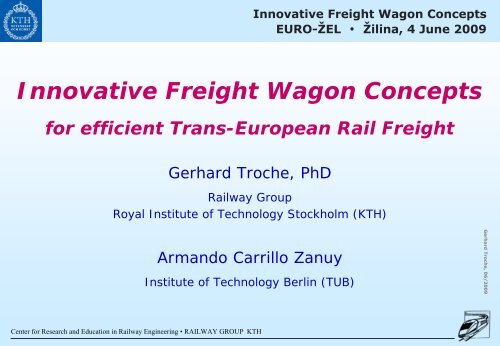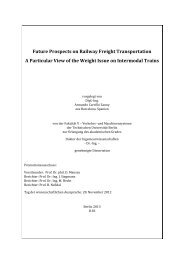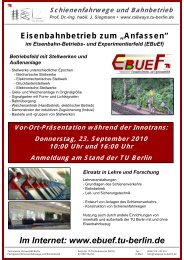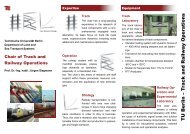Innovative Freight Wagon Concepts EURO-ŽEL
Innovative Freight Wagon Concepts EURO-ŽEL
Innovative Freight Wagon Concepts EURO-ŽEL
Create successful ePaper yourself
Turn your PDF publications into a flip-book with our unique Google optimized e-Paper software.
<strong>Innovative</strong> <strong>Freight</strong> <strong>Wagon</strong> <strong>Concepts</strong><br />
<strong>EURO</strong>-ŽEL • Žilina, 4 June 2009<br />
<strong>Innovative</strong> <strong>Freight</strong> <strong>Wagon</strong> <strong>Concepts</strong><br />
for efficient Trans-European Rail <strong>Freight</strong><br />
Gerhard Troche, PhD<br />
Railway Group<br />
Royal Institute of Technology Stockholm (KTH)<br />
Armando Carrillo Zanuy<br />
Institute of Technology Berlin (TUB)<br />
Gerhard Troche, 06/2009<br />
Center for Research and Education in Railway Engineering • RAILWAY GROUP KTH
<strong>Innovative</strong> <strong>Freight</strong> <strong>Wagon</strong> <strong>Concepts</strong><br />
<strong>EURO</strong>-ŽEL • Žilina, 4 June 2009<br />
How to improve competitiveness of<br />
rail freight<br />
• Increase economies of scale<br />
To improve productivity / reduce costs per output-unit<br />
improving cost competitiveness of rail freight<br />
• Introduce new production systems<br />
To respond to new market demands / enter into new<br />
market-segments<br />
improving quality competitiveness of rail freight<br />
Gerhard Troche, 06/2009<br />
Center for Research and Education in Railway Engineering • RAILWAY GROUP KTH
<strong>Innovative</strong> <strong>Freight</strong> <strong>Wagon</strong> <strong>Concepts</strong><br />
<strong>EURO</strong>-ŽEL • Žilina, 4 June 2009<br />
The role of freight wagons<br />
• Key production resource for railway companies<br />
• Important determinant of costs and quality of transport services<br />
(typically 15-25% of total transport costs)<br />
• Influences transport customer’s logistics in loading/unloading<br />
process<br />
• Strong interdependencies with rail infrastructure (e.g. axle-loads,<br />
loading gauges, etc.)<br />
Gerhard Troche, 06/2009<br />
Center for Research and Education in Railway Engineering • RAILWAY GROUP KTH
Situation today<br />
<strong>Innovative</strong> <strong>Freight</strong> <strong>Wagon</strong> <strong>Concepts</strong><br />
<strong>EURO</strong>-ŽEL • Žilina, 4 June 2009<br />
• Seperate wagon fleets for trainload, wagonload and intermodal<br />
- trainload: specialized wagons<br />
- wagonload: multipurpose wagons<br />
- intermodal: dedicated fleet for intermodal traffic<br />
• Existing norms and standards not necessarily adequate to respond to<br />
future market demands due to changing competitive environment<br />
• Most efficient wagons today are ”exceptions from the standards”<br />
• Careful review of vehicle as well as related infrastructure standards<br />
will be necessary<br />
Gerhard Troche, 06/2009<br />
Center for Research and Education in Railway Engineering • RAILWAY GROUP KTH
<strong>Innovative</strong> <strong>Freight</strong> <strong>Wagon</strong> <strong>Concepts</strong><br />
<strong>EURO</strong>-ŽEL • Žilina, 4 June 2009<br />
Outlines of a new freight wagon concept<br />
• Platform Concept<br />
- to achieve economies of scale in production and maintenance<br />
- several wagon types can be derived<br />
- detachable superstructures<br />
• Two basic designs<br />
- Design A: Long wagon mainly for intermodal / volume-cargo<br />
- Design B: Flat wagon for trailer transport<br />
• Approach<br />
- combine innovative, but proven solutions for sub-systems<br />
rather than developing ’revolutionary’ new solutions with<br />
high technical risks<br />
Gerhard Troche, 06/2009<br />
Center for Research and Education in Railway Engineering • RAILWAY GROUP KTH
<strong>Innovative</strong> <strong>Freight</strong> <strong>Wagon</strong> <strong>Concepts</strong><br />
<strong>EURO</strong>-ŽEL • Žilina, 4 June 2009<br />
Examples of flexible superstructures (I)<br />
Gerhard Troche, 06/2009<br />
Center for Research and Education in Railway Engineering • RAILWAY GROUP KTH
<strong>Innovative</strong> <strong>Freight</strong> <strong>Wagon</strong> <strong>Concepts</strong><br />
<strong>EURO</strong>-ŽEL • Žilina, 4 June 2009<br />
Examples of flexible superstructures (II)<br />
Gerhard Troche, 06/2009<br />
Center for Research and Education in Railway Engineering • RAILWAY GROUP KTH
Key parametres<br />
• Axle-loads: 25 tons (optionally more)<br />
<strong>Innovative</strong> <strong>Freight</strong> <strong>Wagon</strong> <strong>Concepts</strong><br />
<strong>EURO</strong>-ŽEL • Žilina, 4 June 2009<br />
• Loading gauge: UIC GC, extended gauge on selected corridors<br />
• Train length: 750 m (1.000 m) or 2 * 750 m = 1.500 m<br />
• Design speed: Generally 100 km/h at 25 t axle-load,<br />
optionally more at reduced axle-load (120/140/160 km/h)<br />
Gerhard Troche, 06/2009<br />
Center for Research and Education in Railway Engineering • RAILWAY GROUP KTH
<strong>Innovative</strong> <strong>Freight</strong> <strong>Wagon</strong> <strong>Concepts</strong><br />
<strong>EURO</strong>-ŽEL • Žilina, 4 June 2009<br />
Benefits of higher axle-loads<br />
… for heavy cargo (e.g. ore, steel, paper, liquid cargo):<br />
Increased payload per train-length (ton/meter)<br />
Heavy Cargo <strong>Wagon</strong><br />
… for volume cargo (e.g. finished and semi-finished products,<br />
typical intermodal cargo):<br />
Decreased number of axles per train-length (axles/meter)<br />
<strong>Wagon</strong> design A (Long wagon)<br />
Gerhard Troche, 06/2009<br />
Center for Research and Education in Railway Engineering • RAILWAY GROUP KTH
<strong>Innovative</strong> <strong>Freight</strong> <strong>Wagon</strong> <strong>Concepts</strong><br />
<strong>EURO</strong>-ŽEL • Žilina, 4 June 2009<br />
Design A – long wagon (80’)<br />
Today – loading length ca. 19 m<br />
20’ 20’ 20’<br />
Future – loading length ca. 25 m<br />
20’ 20’ 20’ 20’<br />
7,15-7,82 m 7,15-7,82 m<br />
7,15-7,82 m 7,15-7,82 m 7,15-7,82 m<br />
• 33% more capacity when loaded with containers<br />
• better adapted to 40’-containers (~75% of maritime containers)<br />
• 50% more capacity when loaded with C-swap bodies<br />
• frame slightly heavier due to longer span, but bigger distance<br />
between bogies tare weight per meter less than today’s wagons<br />
• tare weight ca. 23-24 ton<br />
Gerhard Troche, 06/2009<br />
Center for Research and Education in Railway Engineering • RAILWAY GROUP KTH
<strong>Innovative</strong> <strong>Freight</strong> <strong>Wagon</strong> <strong>Concepts</strong><br />
<strong>EURO</strong>-ŽEL • Žilina, 4 June 2009<br />
North-Amercian Standard 80’-wagon<br />
Gerhard Troche, 06/2009<br />
Center for Research and Education in Railway Engineering • RAILWAY GROUP KTH<br />
Source: Greenbrier
<strong>Innovative</strong> <strong>Freight</strong> <strong>Wagon</strong> <strong>Concepts</strong><br />
<strong>EURO</strong>-ŽEL • Žilina, 4 June 2009<br />
Australian class CQMY 80’-wagon<br />
Gerhard Troche, 06/2009<br />
Center for Research and Education in Railway Engineering • RAILWAY GROUP KTH
<strong>Innovative</strong> <strong>Freight</strong> <strong>Wagon</strong> <strong>Concepts</strong><br />
<strong>EURO</strong>-ŽEL • Žilina, 4 June 2009<br />
German class Rbns 641/646-wagon<br />
• for transport of steel bars<br />
• Length over buffers = 26,35 m<br />
• also regularly humped in marshalling yards (on special permission)<br />
Gerhard Troche, 06/2009<br />
Center for Research and Education in Railway Engineering • RAILWAY GROUP KTH<br />
Source: DB Schenker Rail
<strong>Innovative</strong> <strong>Freight</strong> <strong>Wagon</strong> <strong>Concepts</strong><br />
<strong>EURO</strong>-ŽEL • Žilina, 4 June 2009<br />
Comparison:<br />
Number of Loading Units per 100 m<br />
Nr of LU per 100 m<br />
18,00<br />
16,00<br />
14,00<br />
12,00<br />
LU<br />
10,00<br />
8,00<br />
6,00<br />
4,00<br />
2,00<br />
0,00<br />
20'-ct 40'-ct 7,45m-swap body<br />
Sgns 60'<br />
Sggmrs 104'<br />
New wagon concept<br />
Gerhard Troche, 06/2009<br />
Center for Research and Education in Railway Engineering • RAILWAY GROUP KTH
<strong>Innovative</strong> <strong>Freight</strong> <strong>Wagon</strong> <strong>Concepts</strong><br />
<strong>EURO</strong>-ŽEL • Žilina, 4 June 2009<br />
Comparison:<br />
Number of loading units per axle<br />
Nr of LU per axle<br />
1,20<br />
1,00<br />
0,80<br />
Sgns 60'<br />
LU<br />
0,60<br />
Sggmrs 104'<br />
0,40<br />
0,20<br />
0,00<br />
20'-ct 40'-ct 7,45m-swap body<br />
New wagon concept<br />
Gerhard Troche, 06/2009<br />
Center for Research and Education in Railway Engineering • RAILWAY GROUP KTH
<strong>Innovative</strong> <strong>Freight</strong> <strong>Wagon</strong> <strong>Concepts</strong><br />
<strong>EURO</strong>-ŽEL • Žilina, 4 June 2009<br />
Comparison:<br />
Maximum payload per loading unit<br />
Maximum payload per LU (with regard to axle-load !)<br />
70<br />
60<br />
50<br />
LU<br />
40<br />
30<br />
20<br />
10<br />
0<br />
20'-ct 40'-ct 7,45m-swap body<br />
Sgns 60'<br />
Sggmrs 104'<br />
New wagon concept<br />
typical interval<br />
of payload / LU<br />
Gerhard Troche, 06/2009<br />
Center for Research and Education in Railway Engineering • RAILWAY GROUP KTH
<strong>Innovative</strong> <strong>Freight</strong> <strong>Wagon</strong> <strong>Concepts</strong><br />
<strong>EURO</strong>-ŽEL • Žilina, 4 June 2009<br />
Design B: Flat wagon for semi-trailers<br />
Today – pocket wagon<br />
Excludes >95% of European<br />
semi-trailer fleet !<br />
Future – trailer on flat wagon<br />
Handles 100% of European<br />
semi-trailer fleet<br />
Gerhard Troche, 06/2009<br />
Center for Research and Education in Railway Engineering • RAILWAY GROUP KTH
<strong>Innovative</strong> <strong>Freight</strong> <strong>Wagon</strong> <strong>Concepts</strong><br />
<strong>EURO</strong>-ŽEL • Žilina, 4 June 2009<br />
North American flat wagon for semi-trailers<br />
(TOFC = Trailers on Flat Cars)<br />
Gerhard Troche, 06/2009<br />
Center for Research and Education in Railway Engineering • RAILWAY GROUP KTH
<strong>Innovative</strong> <strong>Freight</strong> <strong>Wagon</strong> <strong>Concepts</strong><br />
<strong>EURO</strong>-ŽEL • Žilina, 4 June 2009<br />
Approach for European TOFC-solution<br />
Combination of:<br />
• Slightly decreased floor height – 800 mm<br />
• Slightly increased loading gauge – 4.800 mm (on<br />
relevant corridors)<br />
Sharing the responsibility for implementation<br />
between wagon design and infrastructure development<br />
Gerhard Troche, 06/2009<br />
Center for Research and Education in Railway Engineering • RAILWAY GROUP KTH
<strong>Innovative</strong> <strong>Freight</strong> <strong>Wagon</strong> <strong>Concepts</strong><br />
<strong>EURO</strong>-ŽEL • Žilina, 4 June 2009<br />
Different low floor designs today<br />
> 1155 mm<br />
825–950 mm<br />
410–600 mm<br />
Gerhard Troche, 06/2009<br />
Center for Research and Education in Railway Engineering • RAILWAY GROUP KTH
<strong>Innovative</strong> <strong>Freight</strong> <strong>Wagon</strong> <strong>Concepts</strong><br />
<strong>EURO</strong>-ŽEL • Žilina, 4 June 2009<br />
Example of low floor wagon<br />
– MEGAFRET-wagon (AAE)<br />
• floor height: 825 mm<br />
• Wheel diameter: 730 mm<br />
• Axle load: 16 tons<br />
• Max.speed: 120 km/h<br />
Gerhard Troche, 06/2009<br />
Center for Research and Education in Railway Engineering • RAILWAY GROUP KTH
<strong>Innovative</strong> <strong>Freight</strong> <strong>Wagon</strong> <strong>Concepts</strong><br />
<strong>EURO</strong>-ŽEL • Žilina, 4 June 2009<br />
Comparison of loading profiles<br />
6.150 mm<br />
Double-Stack-Container-Trains<br />
(two 9’6’’-container in a well wagon)<br />
Swedish loading gauge ’C’<br />
4.800 mm<br />
4.650 mm<br />
UIC ’GC’-gauge<br />
4.320 mm<br />
Swedish loading gauge ’A’<br />
UIC ’GB’-gauge<br />
UIC ’GA’-gauge<br />
3.150 mm<br />
Gerhard Troche, 2009<br />
Gerhard Troche, 06/2009<br />
3.450 mm<br />
3.600 mm<br />
Center for Research and Education in Railway Engineering • RAILWAY GROUP KTH
<strong>Innovative</strong> <strong>Freight</strong> <strong>Wagon</strong> <strong>Concepts</strong><br />
<strong>EURO</strong>-ŽEL • Žilina, 4 June 2009<br />
Proposal for new loading profile<br />
”GC-extended”<br />
2.910 mm<br />
”GC-extended”<br />
(4 m-trailer on 80cm-flatcar)<br />
4.800 mm<br />
4.650 mm<br />
UIC ’GC’-gauge<br />
3.150 mm<br />
Gerhard Troche, 2009<br />
Gerhard Troche, 06/2009<br />
Center for Research and Education in Railway Engineering • RAILWAY GROUP KTH
<strong>Innovative</strong> <strong>Freight</strong> <strong>Wagon</strong> <strong>Concepts</strong><br />
<strong>EURO</strong>-ŽEL • Žilina, 4 June 2009<br />
Options for the future<br />
• utilize loading gauge for other wagon<br />
types<br />
Example 1<br />
Gerhard Troche, 06/2009<br />
Center for Research and Education in Railway Engineering • RAILWAY GROUP KTH
<strong>Innovative</strong> <strong>Freight</strong> <strong>Wagon</strong> <strong>Concepts</strong><br />
<strong>EURO</strong>-ŽEL • Žilina, 4 June 2009<br />
Comparison of SECU-unit<br />
with other transport options<br />
Gerhard Troche, 06/2009<br />
Center for Research and Education in Railway Engineering • RAILWAY GROUP KTH<br />
Source: STORA-ENSO
<strong>Innovative</strong> <strong>Freight</strong> <strong>Wagon</strong> <strong>Concepts</strong><br />
<strong>EURO</strong>-ŽEL • Žilina, 4 June 2009<br />
Options for the future<br />
Example 2<br />
Gerhard Troche, 06/2009<br />
Center for Research and Education in Railway Engineering • RAILWAY GROUP KTH
<strong>Innovative</strong> <strong>Freight</strong> <strong>Wagon</strong> <strong>Concepts</strong><br />
<strong>EURO</strong>-ŽEL • Žilina, 4 June 2009<br />
Other key features<br />
• Automatic central couplers<br />
- allows removal of side buffers and simpler/lighter frame design<br />
(medium-term)<br />
- screw-coupler-compatible central coupler to reduce<br />
implementation barriers<br />
• Electric power supply<br />
- for railway-internal applications (IT)<br />
- for customer applications (e.g. reefer containers/trailers,<br />
operation of sliding doors, …)<br />
energy-supply stationary and during transport<br />
Gerhard Troche, 06/2009<br />
Center for Research and Education in Railway Engineering • RAILWAY GROUP KTH
• Design A (long wagon)<br />
<strong>Innovative</strong> <strong>Freight</strong> <strong>Wagon</strong> <strong>Concepts</strong><br />
<strong>EURO</strong>-ŽEL • Žilina, 4 June 2009<br />
Maximum train weights<br />
with new wagon concept<br />
- at 700 m train-length (excl.locos): 27 wagons – 2.700 tons<br />
- at 1.400 m train-length (excl.locos): 54 wagons – 5.400 tons<br />
• Design B (trailer wagon)<br />
- at 700 m train-length (excl.locos): 45 wagons – 2.880 tons<br />
- at 1.400 m train-length (excl.locos): 90 wagons – 5.760 tons<br />
Gerhard Troche, 06/2009<br />
Center for Research and Education in Railway Engineering • RAILWAY GROUP KTH
<strong>Innovative</strong> <strong>Freight</strong> <strong>Wagon</strong> <strong>Concepts</strong><br />
<strong>EURO</strong>-ŽEL • Žilina, 4 June 2009<br />
Ďakujem za pozornost’ !<br />
gerhard@infra.kth.se<br />
+46 73 941 97 50 (mobile)<br />
Gerhard Troche, 06/2009<br />
Center for Research and Education in Railway Engineering • RAILWAY GROUP KTH





